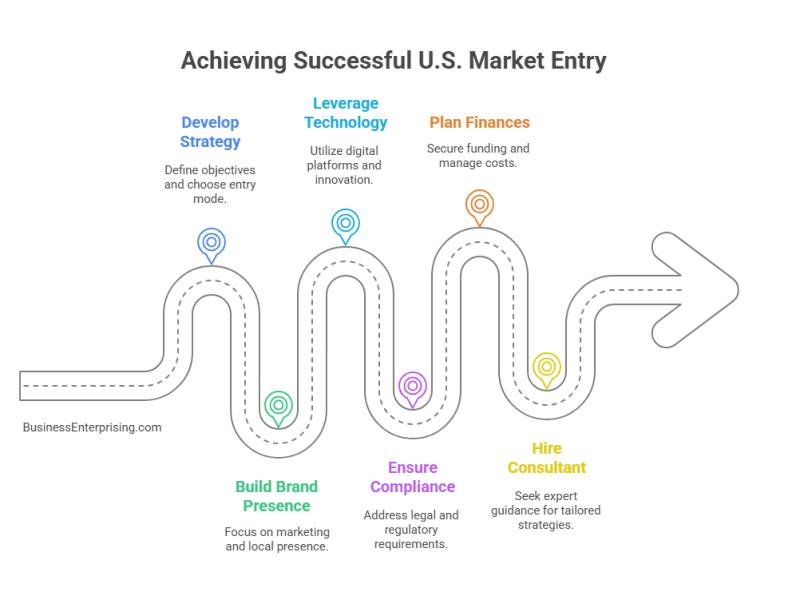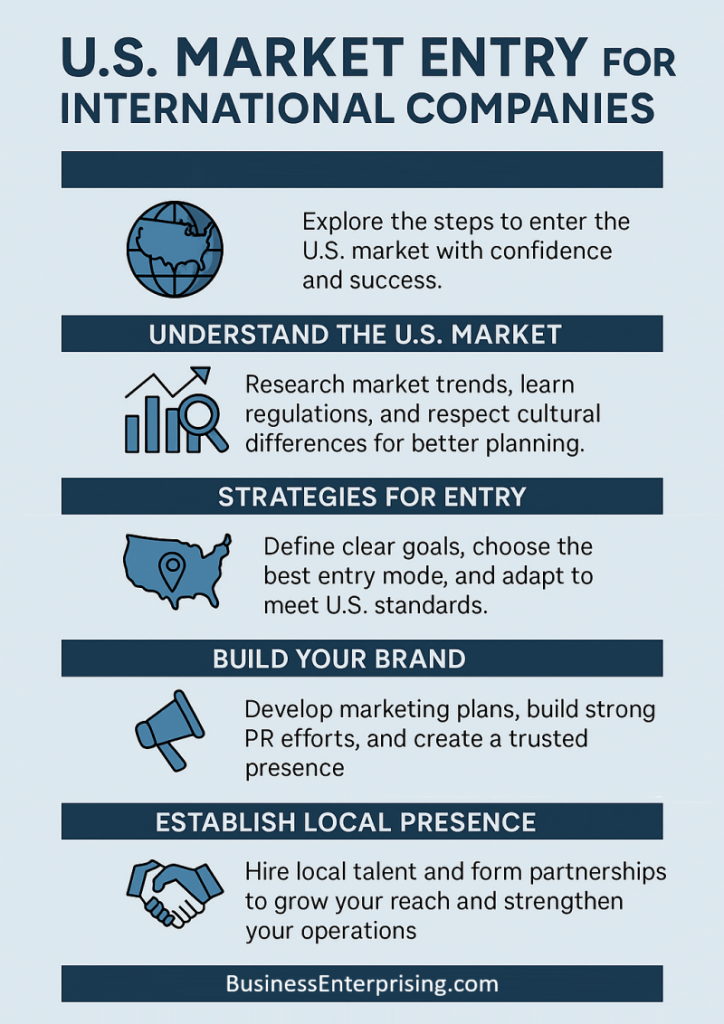
Understanding the U.S. Market
Understanding the U.S. market is essential for any company looking to succeed in U.S. Market Entry. The American market is vast and diverse, and it varies from state to state. Therefore, you need to research and analyze these differences before making any decisions. Additionally, consumer preferences change quickly and can vary by region. This means you should take the time to learn about local tastes and buying habits. Furthermore, understanding what drives these preferences can help you create better products and services.
However, the U.S. market is not only about consumers. It also includes many regulations that can affect your business. Therefore, you should learn about tax laws, trade rules and employment standards. Staying informed will help you avoid costly mistakes later. Moreover, cultural differences play a big role in how people do business. Understanding how people communicate and negotiate can give you an edge. Additionally, respecting these differences helps you build strong relationships with partners and customers.
As you learn about the U.S. market, consider your long-term goals. Are you planning to build a lasting presence? Or are you looking to test the waters before expanding further? Knowing your goals helps you focus your efforts and resources. It also helps to talk to people who know the market well. Local employees and consultants can provide valuable insights and practical advice. Therefore, their input can help you avoid common pitfalls and make smarter decisions.
Finally, take the time to adjust your strategies based on what you learn. The U.S. market rewards companies that can adapt quickly and think ahead. So, keep an open mind and be ready to change course when needed. This flexible approach can help you succeed and stay competitive.
Market Entry Considerations
The U.S. market is diverse and complex, characterized by varying consumer preferences, regulatory frameworks, and competitive dynamics across different states and regions. To successfully enter and thrive in this market, international companies must thoroughly understand the following aspects:
Market Research and Analysis
Conduct comprehensive market research to identify potential demand for your products or services. In addition, analyze consumer behavior, market trends, as well as the competitive landscape to gain insights into market opportunities and challenges.
Regulatory Environment
Equally important, familiarize yourself with federal, state, and local regulations that may impact your business operations. This includes understanding tax laws, employment regulations, trade compliance, and industry-specific standards.
Cultural Differences
Recognize and respect cultural differences that may influence consumer preferences and business practices. Tailor your marketing strategies and customer engagement approaches to resonate with the local audience.
Strategies for Successful U.S. Market Entry
Develop a Comprehensive Market Entry Strategy
Define Your Objectives: Clearly outline your goals for U.S. market entry. Are you looking to increase sales, enhance brand visibility, or establish a long-term presence? Defining your objectives will guide your strategy and decision-making process.
Choose the Right Entry Mode: Also, consider various entry modes such as exporting, licensing, franchising, joint ventures, or establishing a subsidiary. Each mode has its advantages and risks, and the choice will depend on your resources, risk tolerance, and market objectives.
Adapt Your Product or Service:
Localization: Adapt your products or services to meet local tastes, preferences, and especially regulatory requirements. This may involve modifying product features, packaging, pricing, or even developing new offerings tailored to the U.S. market.
Quality and Standards: Ensure your products comply with U.S. quality standards and regulations. Obtain necessary certifications and adhere to industry-specific requirements to build trust and credibility.
Build a Strong Brand Presence
Marketing and Advertising: Develop a robust marketing and advertising strategy to create awareness and generate interest in your brand. Utilize digital marketing, social media, and traditional advertising channels to reach your target audience.
Public Relations: Engage in public relations activities to build a positive brand image. Collaborate with local media, participate in industry events, and leverage influencer partnerships to enhance visibility and credibility.
Establish a Local Presence:
Hire Local Talent: Recruit local employees who understand the market dynamics and cultural nuances. Local talent can provide valuable insights and help bridge any gaps between your company and the local market.
Partnerships and Alliances: Form strategic partnerships with local businesses, distributors, or suppliers to enhance your market reach and operational efficiency. Collaborations can provide access to established networks and resources.
Leverage Technology and Innovation
E-commerce and Digital Platforms: Utilize e-commerce platforms and digital technologies to expand your market reach and streamline operations. An effective online presence can enhance customer engagement and drive sales.
Innovation and Adaptability: Embrace innovation to stay competitive and meet evolving market demands. Continuously monitor market trends and adapt your offerings to stay relevant and appealing to U.S. consumers.
Compliance and Legal Considerations
Legal Structure: Choose the appropriate legal structure for your U.S. operations, such as a corporation, LLC, or partnership. Consult with legal experts to ensure compliance with local laws and regulations.
Intellectual Property Protection: Protect your intellectual property by registering trademarks, patents, and copyrights in the U.S. This safeguards your brand and innovations from infringement and misuse.
Financial Planning and Investment
Funding and Capital: Furthermore, secure sufficient funding to support your market entry and expansion efforts. Explore various financing options, including venture capital, private equity, or government grants.
Cost Management: Develop a detailed financial plan to manage costs effectively. Consider expenses related to market research, localization, marketing, legal compliance, as well as operational setup.
Hire a Consultant
Expert Guidance: Consider hiring a consultant with experience in U.S. market entry to guide you through the process. Consultants can provide valuable insights, assist with market research, and help navigate regulatory and legal complexities.
Tailored Strategies: Lastly, a consultant can work with you to develop tailored strategies that align with your business goals and market conditions. Their expertise can help mitigate risks and ensure a smoother market entry.
Entering the U.S. market presents significant opportunities for international companies, but it also requires careful planning, strategic execution, and a deep understanding of local dynamics. By developing a comprehensive market entry strategy, adapting products or services, building a strong brand presence, establishing a local footprint, leveraging technology, ensuring compliance, planning financial investments, and considering the expertise of a consultant, companies can navigate the complexities of the U.S. market and achieve sustained success.
Successful U.S. market entry is not just about entering a new market but about creating lasting value and building a strong foundation for growth. With the right approach, international companies can unlock the vast potential of the U.S. market and thrive in one of the world’s most dynamic economies.


